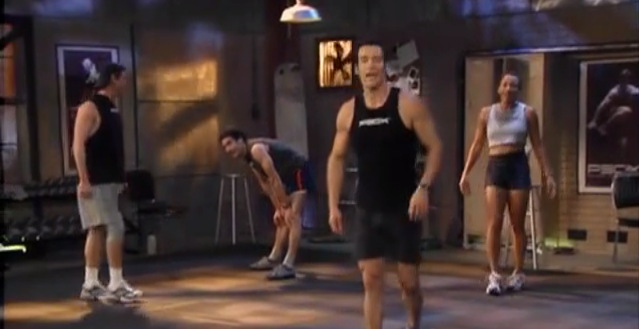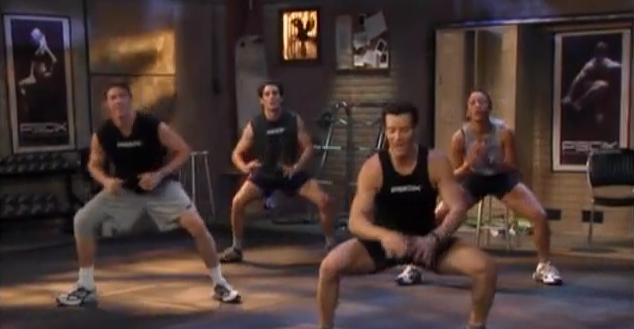Everything Wrong with P90X Plyometrics
P90X Plyometrics is a tough routine, but don’t let the name mislead you. It hardly qualifies as a plyometric workout.
The workout features many jumps, skips and hops, which might initially appear to be plyometric exercises. After all you’ll often hear plyometric workouts referred to as “jump training.” However, according to Brandon McGill, sports performance director for STACK Velocity Sports Performance, just because you jump doesn’t mean you’re doing a plyometric exercise.
“Plyometrics is not necessarily jump training.” he says. “P90X Plyometrics is really just P90X jumping.”
In the intro to the workout, host Tony Horton says, “If you’re doing plyometrics, you can jump higher and run faster.” This is true. Plyometric exercises work by enhancing the stretch-shortening cycle (SSC), a process that occurs in your muscles when they lengthen and quickly contract to release elastic energy. Training the SSC improves your muscles’ ability to store and quickly use this energy as power, but it is wasted as heat if you move too slowly.
To train the SSC, you must perform exercises at max power with full recovery and a focus on limiting the amount of time your feet spend on the ground. This challenges your muscles, causing them to get more powerful. This is where P90X Plyometrics falls short. Here’s why:
The Workout is 45 Minutes Long
P90X Plyometrics runs 60 minutes long, but the actual workout lasts about 45 minutes—there’s a 10-minute warm-up and a five-minute cooldown. It would be extremely difficult, if not impossible, to perform exercises with max power for that long.
A plyometric workout is typically performed along with a strength-training program. The athlete warms up, then performs plyometrics for no more than 15-20 minutes before going into the strength portion of his or her workout. This strategy allows you to perform every rep powerfully and with optimal form.
There Are Too Many Reps
Plyometric workouts are carefully designed to produce maximum gains without causing too much fatigue. This is achieved by performing 3 to 8 powerful and clean reps for 3 to 6 sets—the exact number depending on where you are in your training, the type of exercise and your goals.
In P90X, exercises are performed for about 30 seconds each. After some of the more intense moves, you can see one of the guys on camera hunched over panting for breath. Even Tony Horton is breathing hard. In a real plyometric workout, you would not experience this type of fatigue.
Rest Periods Are Too Short
There are about 15-30 seconds of rest between moves in P90X Plyometrics, which is usually the time it takes to stop one exercise and set up for the next. The result is a 2:1 work-to-rest ratio, which looks more like interval training—Tabata uses the same work-to-rest ratio—than a plyometric workout. To train the SSC, you need to be fully recovered or you won’t be powerful. That’s why it’s recommended to rest three to five times longer than the time it takes to complete a set. If you applied this concept to P90X, you’d be resting for at least 90 seconds after each set.
The Exercises Aren’t Actually Plyometric
Believe it or not, there are actually very few plyometric exercises in the workout. One key defining characteristic of a plyometric exercise is limiting ground contact time. So for example, when you land from a jump you immediately jump again.
Except for Jump Knee Tucks, very few exercises in the P90X program fit this description. Instead, most of the moves have controlled landings with extended ground contact time, which removes the SSC from the movement. In the image above, the individuals are performing a Sumo Squat Isometric Hold while hopping forward and backward. Is this challenging? Absolutely. Your thighs will light on fire. Is it a plyometric move? Nope.
Not every single exercise in a plyometric program has to be a complete plyometric exercise. For example, Box Jumps only work on one part of the SSC. But they’re still done at max intensity, which the P90X exercises lack, due to the factors discussed above.
There’s no denying that P90X Plyometrics is intense. It’s an extremely challenging workout, and it will get you in shape. However, it’s a conditioning workout with some jumping, skipping and hopping exercises, not a plyometric program that develops explosive power.
In a true plyometric workout, you won’t be gasping for air, holding your knees and feeling the burn within your muscles. McGill says, “Fatigue from a true plyometric workout is primarily neurological. At the end of a plyo workout, you might feel a little sluggish and not as responsive. The next day your legs are going to feel heavy.”
You might experience some power benefits from P90X Plyometrics as a byproduct of moving more and getting in better shape—especially if you’re not serious with your training.
“I can’t say it’s not going to make you more powerful,” explains McGill. “Jumping a lot will make you jump more efficiently at the start, but it will only take you so far.”
Serious athletes cannot expect to use this workout to reach the athletic goals of running faster and jumping higher.
Read More:
Try the 10 Best Plyometrics for Athletes
The Benefits of Upper-Body Plyos
RECOMMENDED FOR YOU
MOST POPULAR
Everything Wrong with P90X Plyometrics
P90X Plyometrics is a tough routine, but don’t let the name mislead you. It hardly qualifies as a plyometric workout.
The workout features many jumps, skips and hops, which might initially appear to be plyometric exercises. After all you’ll often hear plyometric workouts referred to as “jump training.” However, according to Brandon McGill, sports performance director for STACK Velocity Sports Performance, just because you jump doesn’t mean you’re doing a plyometric exercise.
“Plyometrics is not necessarily jump training.” he says. “P90X Plyometrics is really just P90X jumping.”
In the intro to the workout, host Tony Horton says, “If you’re doing plyometrics, you can jump higher and run faster.” This is true. Plyometric exercises work by enhancing the stretch-shortening cycle (SSC), a process that occurs in your muscles when they lengthen and quickly contract to release elastic energy. Training the SSC improves your muscles’ ability to store and quickly use this energy as power, but it is wasted as heat if you move too slowly.
To train the SSC, you must perform exercises at max power with full recovery and a focus on limiting the amount of time your feet spend on the ground. This challenges your muscles, causing them to get more powerful. This is where P90X Plyometrics falls short. Here’s why:
The Workout is 45 Minutes Long
P90X Plyometrics runs 60 minutes long, but the actual workout lasts about 45 minutes—there’s a 10-minute warm-up and a five-minute cooldown. It would be extremely difficult, if not impossible, to perform exercises with max power for that long.
A plyometric workout is typically performed along with a strength-training program. The athlete warms up, then performs plyometrics for no more than 15-20 minutes before going into the strength portion of his or her workout. This strategy allows you to perform every rep powerfully and with optimal form.
There Are Too Many Reps
Plyometric workouts are carefully designed to produce maximum gains without causing too much fatigue. This is achieved by performing 3 to 8 powerful and clean reps for 3 to 6 sets—the exact number depending on where you are in your training, the type of exercise and your goals.
In P90X, exercises are performed for about 30 seconds each. After some of the more intense moves, you can see one of the guys on camera hunched over panting for breath. Even Tony Horton is breathing hard. In a real plyometric workout, you would not experience this type of fatigue.
Rest Periods Are Too Short
There are about 15-30 seconds of rest between moves in P90X Plyometrics, which is usually the time it takes to stop one exercise and set up for the next. The result is a 2:1 work-to-rest ratio, which looks more like interval training—Tabata uses the same work-to-rest ratio—than a plyometric workout. To train the SSC, you need to be fully recovered or you won’t be powerful. That’s why it’s recommended to rest three to five times longer than the time it takes to complete a set. If you applied this concept to P90X, you’d be resting for at least 90 seconds after each set.
The Exercises Aren’t Actually Plyometric
Believe it or not, there are actually very few plyometric exercises in the workout. One key defining characteristic of a plyometric exercise is limiting ground contact time. So for example, when you land from a jump you immediately jump again.
Except for Jump Knee Tucks, very few exercises in the P90X program fit this description. Instead, most of the moves have controlled landings with extended ground contact time, which removes the SSC from the movement. In the image above, the individuals are performing a Sumo Squat Isometric Hold while hopping forward and backward. Is this challenging? Absolutely. Your thighs will light on fire. Is it a plyometric move? Nope.
Not every single exercise in a plyometric program has to be a complete plyometric exercise. For example, Box Jumps only work on one part of the SSC. But they’re still done at max intensity, which the P90X exercises lack, due to the factors discussed above.
There’s no denying that P90X Plyometrics is intense. It’s an extremely challenging workout, and it will get you in shape. However, it’s a conditioning workout with some jumping, skipping and hopping exercises, not a plyometric program that develops explosive power.
In a true plyometric workout, you won’t be gasping for air, holding your knees and feeling the burn within your muscles. McGill says, “Fatigue from a true plyometric workout is primarily neurological. At the end of a plyo workout, you might feel a little sluggish and not as responsive. The next day your legs are going to feel heavy.”
You might experience some power benefits from P90X Plyometrics as a byproduct of moving more and getting in better shape—especially if you’re not serious with your training.
“I can’t say it’s not going to make you more powerful,” explains McGill. “Jumping a lot will make you jump more efficiently at the start, but it will only take you so far.”
Serious athletes cannot expect to use this workout to reach the athletic goals of running faster and jumping higher.
Read More:
Try the 10 Best Plyometrics for Athletes
The Benefits of Upper-Body Plyos













